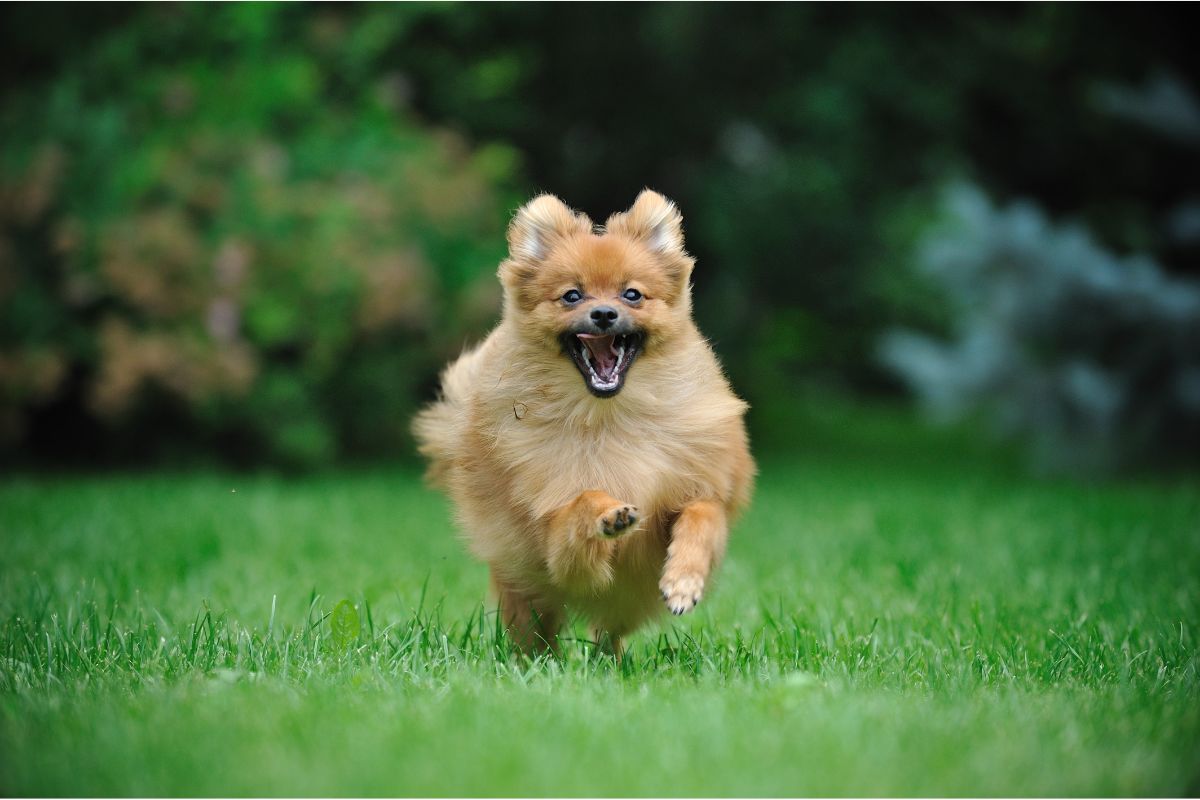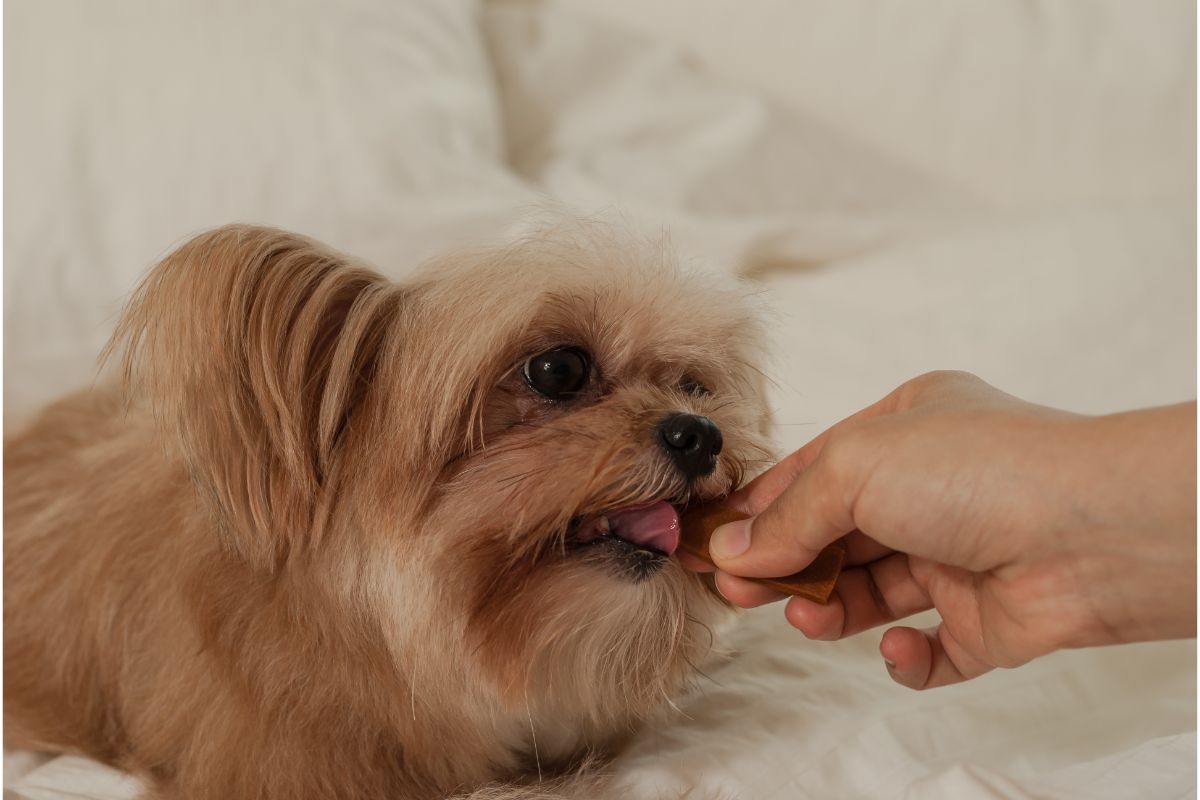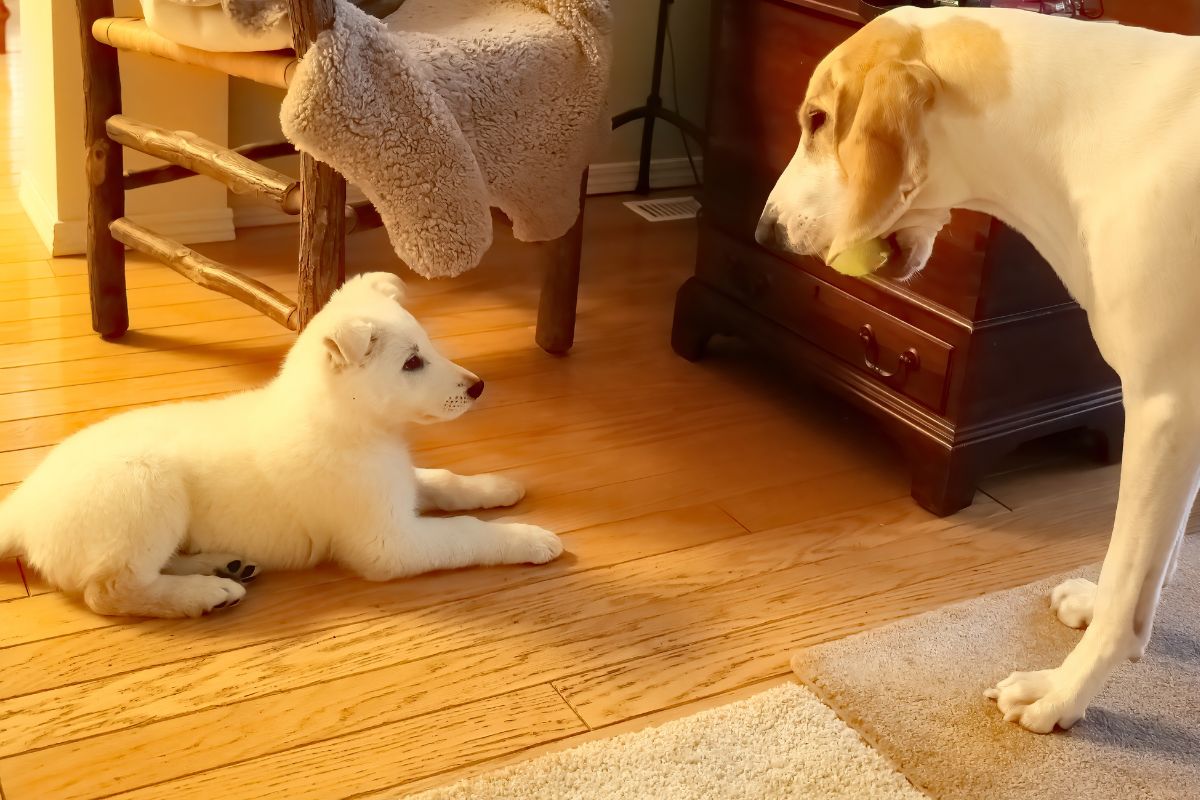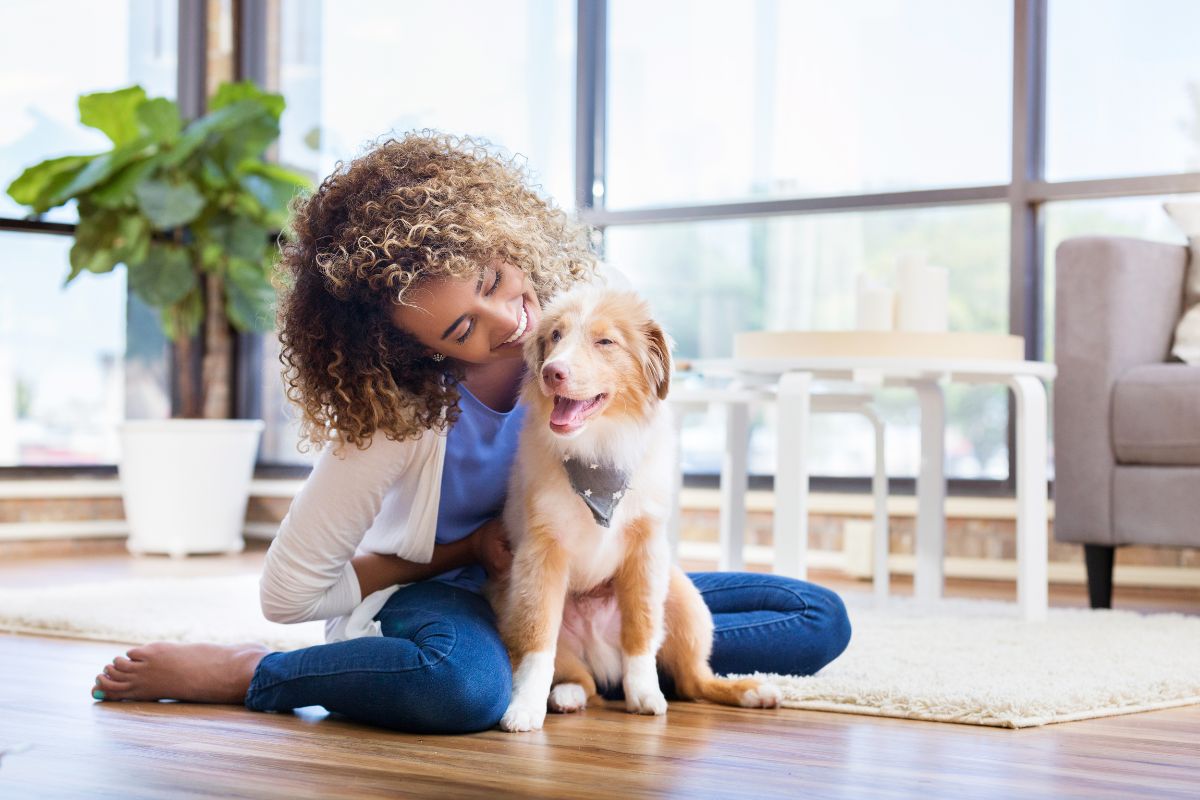Dogs are highly intelligent creatures. They all have their own little quirks and behaviors that we love.
The issue with dogs is that they cannot communicate with us, so we have to comprehend and understand the little things that they do to find out how they are feeling, or what emotional state they are in.
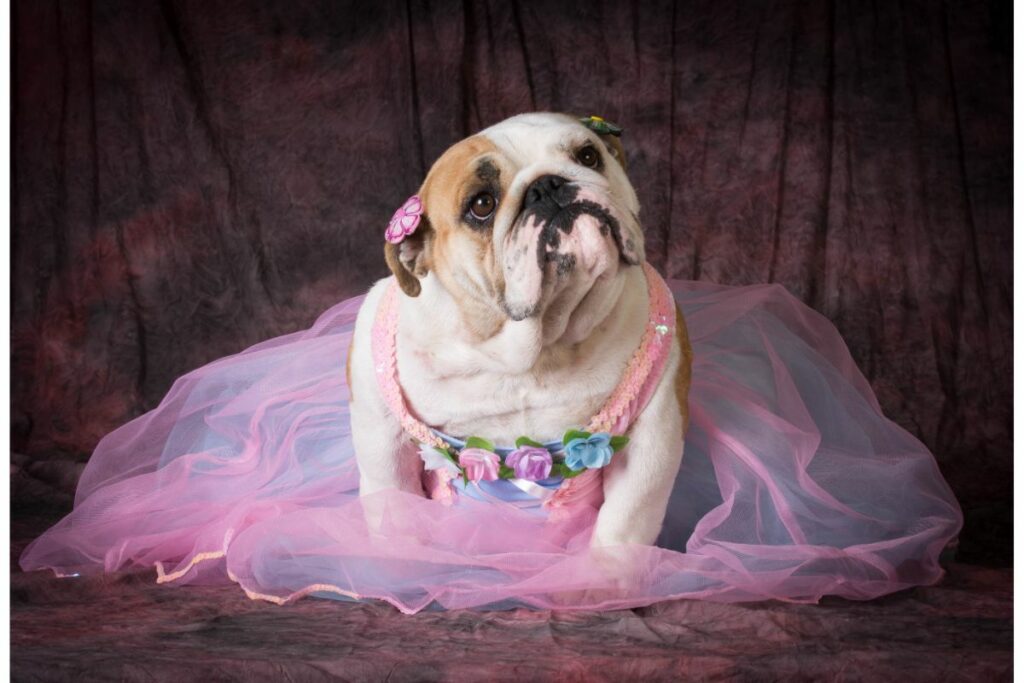
Some dogs can be really confident, whereas others can be nervous around new people, new objects in the home, or anything that they haven’t experienced before.
Fear is a natural emotion, but dogs can go through ‘fear periods’ in their lives.
This is completely normal, but it can often cause concern among owners.
In this guide, we’ll go over everything there is to know about fear periods in dogs, including what they are, why they happen, and what you can do to make your dog feel more comfortable.
What Are Fear Periods In Dogs?
Fear periods are temporary lapses in your dog’s development that can lead to behavioral changes, and more anxious and nervous behavior.
These fear periods typically occur during the first year of your dog’s life.
Fear periods can happen a few times during your dog’s first year, and can come as a surprise to the owner, especially if the dog is typically not afraid of anything!
Your dog may act suspicious or may be spooked by things very easily.
Why Do Dogs Get Fear Periods?
Fear periods happen when there is a cognitive change during your pup’s development process. This isn’t something to worry about, it is completely normal, and many dogs will go through this.
During these fear periods, your dog’s brain is changing, altering, and reorganizing how it responds to certain stimuli. This is part of your dog growing up into an adult, mature dog.
During a fear period, your dog’s body is biologically changing so that they can become more independent, self sufficient, and confident.
While it is not something to worry about, and will usually pass without an issue, it is important that dog owners are aware of fear periods, and know how to manage them.
You do not want your dog to develop a pattern of being fearful of things, as this can lead to nervous behaviors, and even aggressive or defensive behaviors that are fear-provoked.
Dogs need to be confident of their surroundings, happy to interact with all manner of stimuli. But, we’ll talk more about that later!
Signs Of A Fear Period

Fear periods can seemingly come out of nowhere, and often occur when your dog grows up. However, there are some signs that your dog is reaching this part in their life.
The biggest sign is a sudden change in behavior. Your dog may have been the most confident puppy in the world, happy to interact with various people, strangers, dogs, and other animals.
All of a sudden, your dog may be fearful of interacting with people, or going close to them. They may appear nervous around unfamiliar surroundings, or unfamiliar objects in their vicinity.
Another sign that your dog is going through a fear period is when they begin to startle very easily. They may become nervous, or seek you out for affection and protection when there is a sudden change.
This could be a change in the environment, like a new piece of furniture in the home, or when an object is moved.
When there are loud noises in the area, or fast movements, your dog may become anxious or fearful. They may hide between your legs, or move to a safe space such as their crate.
Some dogs can even be fearful of their own reflection, and ‘spook’ very easily for no real reason at all.
During a fear period, your dog may also begin to display prominent body language and behavior that represents their fear.
For instance, your dog may bark at certain objects, people, animals, or things near them or in their line of sight. They may start urinating when nervous, or they could tuck in their tail between their hind legs.
Some dogs may also have pinned back ears, which is a sign of anxiety and fear, or they may have wide ‘whale’ eyes that demonstrates that they are nervous about something.
These behaviors are ones that they may not have done before, so don’t be worried, and don’t punish them. They are not doing it on purpose, and are acting purely out of worry, fear, or anxiety.
In most cases, you can tell if your dog is going through a fear period because their behavior has changed from what it once was.
Your dog may be suddenly fearful of an object in your home that has always been there, such as a mop or a vacuum. They may try to avoid these objects, or run away when you go to use them.
When Do Fear Periods In Dogs Occur?
Fear periods in dogs can occur seemingly out of nowhere. You may not expect them to happen, and they can occur unpredictably.
It does vary from dog to dog, as some may not experience fear periods at all during their lifetime.
In most cases, fear periods will occur in the prime developmental stages of life. For most dogs, this means that fear periods will happen between 8-11 weeks of age, and around 6-16 months of age.
The first fear period is obviously when your dog is a puppy. From 8-11 weeks of age they are still very young and early into their puppyhood.
This fear period can often occur because they are going through a tough transition.
Puppies at this age have been taken from their littermates, and have been introduced to a new household. It can be a lot for them to handle, and they are trying to take it all in.
Everything is new to them, and they could be introduced to things that they have never seen before such as new humans, new animals, new objects, new smells, and a new environment.
During this time, it is important to introduce them to new things in a positive way to build a positive relationship with those things around them.
This can minimize stress and fear, and can prevent those objects or things from becoming a life-long fear for them.
Another common fear period stage is when the dog is around 6 months to 16 months old. This is when your dog is transitioning into the adolescent and adult stage of their lives.
This is typically the fear period that owners struggle with the most.
This is because by this time, your bond with your dog is already likely established. You may already know their likes, dislikes, and quirks.
This makes it much more surprising when your dog suddenly is afraid of things like never before.
This is a prime time to support your dog, and help them understand that there is nothing to be fearful of. This can also happen at the ‘regression’ stage.
What this means is that when your dog is a teenager, they can start to test the boundaries, and go backwards in terms of training.
Things that you have already taught them, such as obedience and recall can sometimes go out the window, and you will have to start over and be consistent with training.
Sometimes, this regression can happen because they are going through a fear period. They may start to ignore you more, and you may notice a decline in their obedience.
What To Do When Your Dog Is Going Through A Fear Period

What to do when your dog is going through a fear period depends on how old the dog is.
If your dog is a puppy, around the 8-11 week mark, or the 6-16 month mark, then there are a few things that you can do to ensure that they grow their confidence, and are not fearful.
Puppies At 8-11 Weeks Old
We recommend allowing your puppy to settle into their new surroundings.
When you first bring them home, let them wander (on a lead) around your home, taking in all of the smells, rooms, and different objects around them.
This can help them feel more comfortable and safe in the home, and nothing will surprise them.
You should also let them settle in for a few days before you start worrying about behavior. It’s a big transition for them. It is also a good idea to start socializing your puppy as soon as you can.
As long as it is done safely, you should socialize your puppy around other people, dogs, and animals when you can. Just ensure that they have had all of their shots and immunizations first.
If your puppy is rather fearful, then do not do anything that could exaggerate that fear.
For instance, if they are fearful of the vacuum, then do not chase them with it. Your puppy will not understand that it is a game or a bit of fun for you.
Also, if they are fearful, then do not force them to interact with other dogs and animals if they appear uncomfortable. This can only make the situation worse. Try to encourage positive interactions.
It could be worth crate training your puppy to ensure that they have a safe space to retreat to. This should be done with positive reinforcement, with lots of praise and treat giving!
When it comes to taking them to the veterinarian, ensure you have a vet who is aware of the puppy’s fear.
They can take precautions, such as not restraining them, and taking things slow with lots of treats so that the puppy can build up a positive relationship with going to the vets, rather than a negative one.
Dogs At 6 – 16 Months Old
When your dog is going through the adolescent stage, it can be a little harder to manage the fear period.
This is a pivotal time in your dog’s training, and in their lives, so you will have to be very careful in how you treat them.
If your adolescent dog is starting to become fearful, then it is a good idea to minimize the risk of a reaction by not forcing them into training methods, socialization situations or more that could cause a negative response.
Physical corrections, bark collars, and shouting at your dog can only exaggerate the negative and fear-based problem.
Instead, use positive reinforcement when training, and try to be patient when things don’t always go to plan.
You can strengthen your bond with your dog during this time with one-on-one training, games, puzzles, and agility training.
If your dog is particularly fearful of others, then doing things in a protected environment alone is far more beneficial. You can still work on your training and reduce the fearful behaviors.
You can still socialize your dog! However, if your dog is nervous around others, then get them to look from afar.
Perhaps sit on a park bench away from others, and get your dog to sit or lie down, and take in their surroundings without interacting with anyone.
Create positive experiences, and always reward desired behaviors. If they are sitting by you calmly, or exploring a new situation without fear slowly, then you can reward them.
Forcing them into meeting other dogs during this time can be catastrophic. One bad experience can lead to a lifetime of reactivity.
It is especially important not to let your dog off leash in public areas around other animals during this time. They can react negatively to a dog, leading to defensive or aggressive behaviors due to their fear.
Most importantly, be patient. It will pass, and your dog will get over their fear much sooner if they can explore and understand their surroundings safely, and without expectation.
What If The Fear Period Is Never Ending?
A fear period is a sudden change in behavior that doesn’t last forever.
If your dog or puppy has been experiencing fearful behavior for a number of weeks or months, then it could be a sign that your dog has an anxiety or fear-related behavioral issue (see also “How To Introduce Your Dog To A New Puppy“).
In these cases, it is best to speak to a dog behaviorist or professional for help and guidance.
Final Thoughts
To summarize, fear periods are short periods when your dog is growing up where they suddenly become fearful of new situations, people, animals, or environments.
These periods will pass, and your dog will soon grow more confident if you support them and continue with their training.
- How To Teach Your Puppy Their Name Easily! - July 18, 2023
- Is Your Puppy Counter Surfing? Find Out How To Stop It! - July 18, 2023
- How To Train Your Puppy For Car Rides: Everything You Need To Know - July 18, 2023


